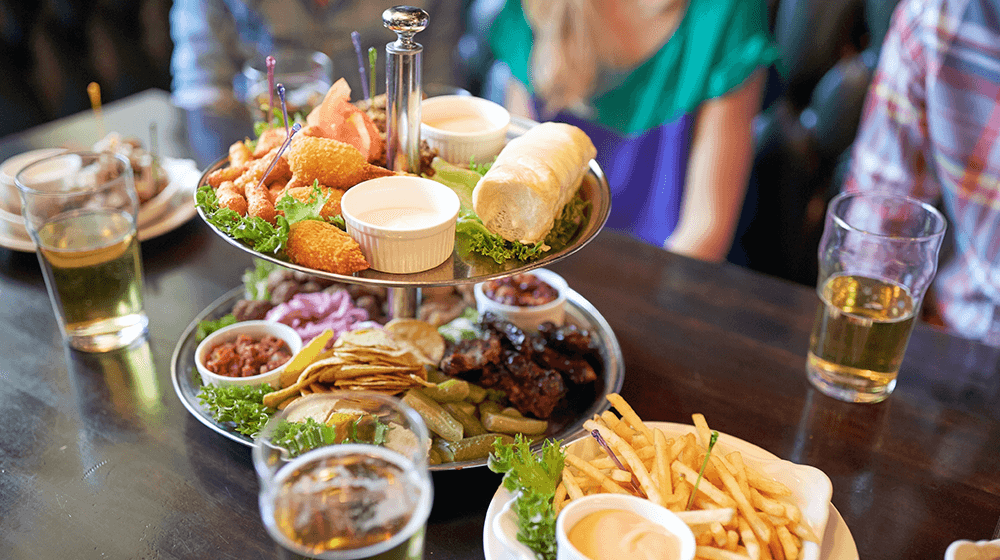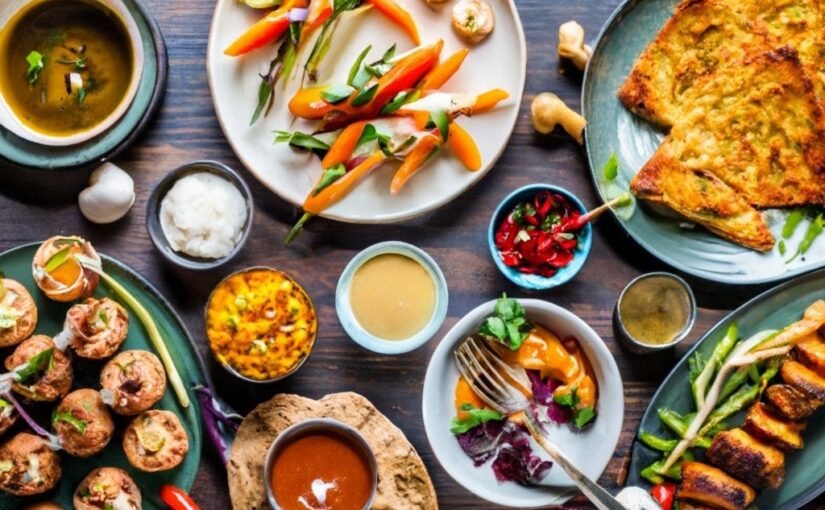The evolution of bar food has been shaped by a myriad of cultural influences from around the world. From traditional pub grub in the United Kingdom to tapas in Spain and izakaya in Japan, the global landscape of bar cuisine offers a diverse tapestry of flavors and culinary techniques. In this article, we embark on a gastronomic adventure to explore the rich and varied influences that have contributed to the evolution of bar food across different continents. And as modern trends continue to shape culinary landscapes, innovations like electric mountain bikes for food delivery are also leaving their mark on the way we enjoy bar cuisine.
Traditional Roots: Exploring the Origins of Bar Food

Bar food, in its simplest form, has its origins deeply rooted in the concept of communal dining and socializing. In ancient civilizations, taverns and alehouses served as gathering places where patrons could enjoy simple, hearty fare along with their drinks. In Europe, the concept of serving food in drinking establishments dates back centuries, with taverns in England offering pies, stews, and other hearty dishes to accompany ale and beer. Similarly, the Spanish tradition of tapas, small savory dishes served with drinks, traces its roots to the practice of covering glasses with slices of bread or meat to prevent fruit flies from hovering over the sweet sherry. When patrons gather in these establishments, ensuring their comfort is paramount, including adequate heating and cooling, which is where reliable HVAC services in Naples FL, come into play.
As European explorers traveled to distant lands, they brought their culinary traditions with them, influencing the food cultures of the regions they encountered. In the Americas, for example, the concept of bar food evolved alongside the growth of colonial settlements, with taverns and inns serving as hubs for socializing and trading. American bar food, characterized by dishes such as buffalo wings, sliders, and nachos, reflects a blend of indigenous ingredients and culinary techniques from Europe.
If you are planning to move to Europe make sure to contact the best Houston movers to help you out.
Over time, traditional bar foods have undergone transformations influenced by regional ingredients and cultural preferences. For instance, the British tradition of fish and chips has been adapted in various countries with local seafood and seasonings. Similarly, German beer gardens have inspired the concept of beer and pretzels in many parts of the world, albeit with regional variations in the types of beer and dipping sauces served alongside. If you’re in Los Angeles and looking to learn about initial firearms training in Los Angeles, you might find unique bar snacks at establishments catering to enthusiasts of both worlds, offering a fusion of flavours and
A Global Fusion: The Intersection of Cultures in Bar Cuisine
The globalization of food has further expanded the repertoire of bar food offerings, as culinary influences from around the world converge to create innovative and eclectic menus. In cosmopolitan cities like New York, London, and Tokyo, bars and gastropubs showcase an array of international flavors, drawing inspiration from cuisines as diverse as Mexican, Thai, and Middle Eastern.
The rise of fusion cuisine has also played a significant role in shaping contemporary bar menus, with chefs incorporating ingredients and cooking techniques from different culinary traditions to create unique and inventive dishes. Physical therapy in Austin is not only about rehabilitation exercises but also about guiding individuals towards a healthier lifestyle, much like how chefs blend diverse ingredients to craft delicious and unexpected flavors. Korean barbecue tacos, sushi burritos, and kimchi quesadillas are just a few examples of how traditional flavors are being reimagined and repurposed in the context of bar food.
Moreover, the exchange of culinary knowledge and techniques through globalization has led to a greater appreciation for authenticity and tradition in bar food. While fusion dishes continue to thrive, there is also a growing interest in authentic ethnic cuisines, with bars and pubs specializing in traditional dishes from specific regions. This trend reflects a desire among consumers to explore and celebrate the cultural diversity of food, even in casual dining settings. For such establishments, utilizing custom banners to highlight their unique offerings can effectively attract patrons seeking genuine culinary experiences.
Elevating the Bar: Trends in Modern Bar Food
In recent years, there has been a growing emphasis on quality and innovation in the realm of bar food, as establishments seek to distinguish themselves in a competitive market. The farm-to-table movement has made its mark on bar menus, with a focus on locally sourced, seasonal ingredients and artisanal products. From house-made charcuterie boards to gourmet sliders made with grass-fed beef, bars are elevating the standard of their food offerings to appeal to discerning palates. Additionally, a fence company in Tennessee has seen increased demand for its services as bars expand their outdoor seating areas, providing patrons with a cozy and private ambiance.
Did you know that many famous bars used services from a top-notch company that does web design in Chicago to make their websites?
Furthermore, the influence of health and wellness trends has prompted many bars to offer lighter, more nutritious options alongside traditional pub fare. Plant-based dishes, gluten-free options, and vegan alternatives are becoming increasingly common on bar menus, catering to a growing segment of health-conscious consumers.
Another notable trend in modern bar food is the incorporation of global street food flavors and techniques. From Vietnamese banh mi to Indian samosas, bars are embracing the bold flavors and vibrant spices of street cuisine from around the world, offering patrons a taste of exotic destinations without leaving their neighborhood. This trend not only adds excitement and variety to bar menus but also reflects the growing popularity of street food culture among urban dwellers.
Global Inspirations: Bar Food Beyond Borders

As the world becomes increasingly interconnected, the influence of international cuisines on bar food knows no bounds. From the bustling streets of Bangkok to the vibrant markets of Marrakech, the flavors and aromas of global cuisine find their way onto bar menus, offering patrons a passport to culinary adventures. Thai-inspired chicken satay skewers, Moroccan-spiced lamb sliders, and Indian-inspired samosa bites are just a few examples of how bars are incorporating the diverse flavors of the world into their menus. By embracing global inspirations, bars are able to transport diners to far-flung destinations without ever leaving their seats. Additionally, in Mobile IV therapy in New Jersey, patrons can now enjoy these exotic flavours while rejuvenating with convenient IV therapy services at their fingertips.
In addition to drawing inspiration from specific cuisines, bars are also exploring global culinary trends and techniques to innovate their menus. For example, the rise of street food culture in cities around the world has inspired bars to offer their own twists on classic street food dishes, such as Korean-style tacos and Vietnamese banh mi sliders. By tapping into the zeitgeist of global food trends, bars are able to stay relevant and appeal to adventurous diners who crave new and exciting flavors. Some bars are enhancing their patrons’ dining experiences by providing ergonomic keyboard for those who want to enjoy their meals while catching up on work or browsing the internet.
Furthermore, the globalization of food has also led to an increased emphasis on authenticity and cultural representation in bar cuisine. Bars are partnering with local chefs and food artisans from diverse backgrounds to ensure that their interpretations of international dishes are respectful and true to their origins. By celebrating the diversity of global cuisine, bars are not only offering patrons a taste of different cultures but also fostering a greater appreciation for culinary diversity and heritage.
Reviving Forgotten Traditions: Rediscovering Lost Bar Foods
While many bar foods have stood the test of time, others have faded into obscurity, relegated to the annals of culinary history. However, a growing movement is seeking to revive these forgotten traditions and reintroduce them to modern audiences. From retro cocktails like the Tom Collins and the Old Fashioned to classic dishes like deviled eggs and Scotch eggs, bars are rediscovering the allure of bygone eras and putting a contemporary spin on timeless favorites. By tapping into the nostalgia of yesteryear, bars can offer patrons a taste of the past while celebrating the enduring legacy of bar food.
In addition to resurrecting classic recipes, bars are also exploring historical culinary techniques and ingredients to create unique and authentic dining experiences. For example, the revival of artisanal food preservation methods such as pickling, fermenting, and curing has led to a resurgence of interest in old-world flavors and textures. Bars are incorporating house-made pickles, fermented vegetables, and cured meats into their menus, giving patrons a taste of traditional craftsmanship and culinary heritage. Furthermore, some establishments are even enhancing their ambiance with roller shades in Orange County, evoking a sense of vintage charm reminiscent of old-world taverns.
Furthermore, the rediscovery of lost bar foods is not just a culinary trend but also a cultural phenomenon. Bars are embracing the nostalgia of bygone eras and creating immersive dining experiences that transport patrons back in time. From retro-themed cocktail bars with vintage decor to speakeasy-style establishments with secret entrances and password-only access, bars are embracing the spirit of nostalgia and inviting patrons to step into a bygone era of glamour and sophistication. By reviving forgotten traditions, bars are not only preserving culinary history but also creating memorable and evocative dining experiences for modern audiences. In bustling cities like Toronto, where family car service in Toronto is in demand, such nostalgic bars offer a unique retreat for families seeking a taste of the past in the present day.
Sustainability in Bar Cuisine: Navigating Environmental Challenges
In an era of increasing environmental awareness, the issue of sustainability has become a pressing concern for the food and beverage industry, including bars and restaurants. From reducing food waste to sourcing ethically and responsibly harvested ingredients, bars are taking steps to minimize their environmental footprint and promote eco-friendly practices. Many bars are partnering with local farmers and producers to ensure their ingredients are sourced sustainably, while others are implementing innovative solutions like composting and recycling programs. By prioritizing sustainability in their operations, bars are not only reducing their impact on the planet but also appealing to environmentally conscious consumers who are increasingly mindful of the origins of their food. Additionally, ensuring affordable electrical services is another way bars can maintain their sustainability efforts while managing operational costs efficiently.
Moreover, bars are also exploring alternative sources of protein and incorporating plant-based ingredients into their menus as a sustainable and eco-friendly alternative to traditional meat and dairy products. From plant-based burgers and sausages to dairy-free cheeses and nut-based desserts, bars are offering a wide range of vegan and vegetarian options to cater to the growing demand for sustainable dining choices. By offering escape room in Seattle experiences alongside their plant-based menus, bars are catering to diverse tastes and preferences, ensuring that everyone can find something enjoyable while supporting sustainability efforts.
Additionally, bars are taking steps to reduce single-use plastics and minimize waste in their operations. Many bars are phasing out plastic straws and stirrers in favor of biodegradable or reusable alternatives, while others are investing in energy-efficient appliances and renewable energy sources to reduce their overall environmental impact. By implementing sustainable practices throughout their operations, bars are not only reducing their environmental footprint but also setting an example for the industry as a whole and inspiring positive change in the way food and beverages are produced and consumed. Some establishments have even gone as far as incorporating combat clothes made from recycled materials for their staff uniforms, further emphasizing their commitment to sustainability.
The Art of Pairing: Elevating Bar Food with Beverage Matches

While bar food is often enjoyed alongside a cold beer or a glass of wine, the art of pairing food and beverage goes far beyond the traditional pint and plate. From craft cocktails to artisanal spirits, bars are elevating the dining experience by offering carefully curated beverage matches that complement and enhance the flavors of their food offerings. Whether it’s a bold red wine paired with a juicy burger or a crisp cider paired with a tangy cheese board, the right beverage can elevate the flavors of a dish and create a harmonious dining experience. By mastering the art of pairing, bars are able to provide patrons with a truly immersive sensory experience that engages all the senses.
Moreover, the art of pairing extends beyond alcoholic beverages to include non-alcoholic options such as craft sodas, specialty teas, and house-made mocktails. Bars are increasingly offering non-alcoholic beverage pairings that are specifically designed to complement their food menus, catering to patrons who prefer not to drink alcohol or are looking for alternative options. From herb-infused tonics to fruit-forward shrubs, non-alcoholic beverages are becoming increasingly sophisticated and diverse, offering patrons a wide range of flavors and experiences to explore.
Additionally, bars are also experimenting with unconventional pairing combinations and pushing the boundaries of traditional food and beverage pairings. From pairing savory dishes with sweet cocktails to combining contrasting flavors and textures for a sensory adventure, bars are challenging conventional wisdom and encouraging diners to step out of their comfort zones. By embracing innovation and creativity in their beverage programs, bars are able to offer patrons a truly memorable and unique dining experience that stimulates the palate and excites the senses.
Conclusion: Celebrating the Evolution of Bar Food
In conclusion, the evolution of bar food is a dynamic and ever-changing journey that reflects the diversity and creativity of culinary traditions from around the world. From traditional favorites to innovative new creations, bars continue to push the boundaries of what is possible, offering patrons a diverse array of flavors and experiences to enjoy. As we look to the future, one thing is certain: the culinary landscape of bar food will continue to evolve and adapt, driven by a passion for flavor, a spirit of innovation, and a commitment to quality. So, the next time you find yourself at a bar, take a moment to savor the flavors of the world and raise a toast to the enduring legacy of bar food. Cheers!

